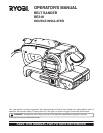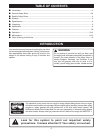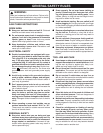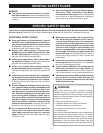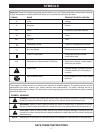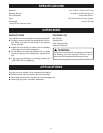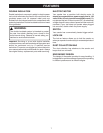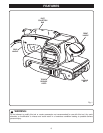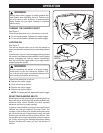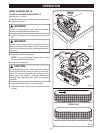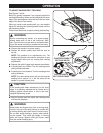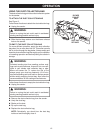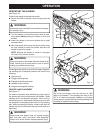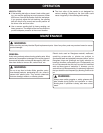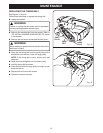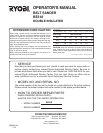
9
OPERATION
WARNING:
Always wear safety goggles or safety glasses with
side shields when operating this tool. Failure to do
so could result in dust, shavings, or loose particles
being thrown into your eyes, resulting in possible
serious injury.
TURNING THE SANDER ON/OFF
See Figure 2.
Follow these directions to turn the sander on and off.
To turn on the sander: Depress the switch trigger.
To turn off the sander: Release the switch trigger.
LOCKING ON
See Figure 3.
The lock-on feature allows you to lock the sander on
when you operate it continuously for extended periods of
time.
If you have the “lock-on” feature engaged during use and
the sander is accidentally disconnected from the power
supply, disengage the “lock-on” feature immediately.
Also, do not lock the trigger switch if you might need to
suddenly stop the sander.
WARNING:
Before connecting the sander to a power supply,
make sure it is not in the “locked-on” position. Fail-
ure to do so could result in accidental starting of the
tool resulting in possible serious injury.
Follow these directions to lock on.
Depress the switch trigger.
Push in the lock-on button.
Release the switch trigger.
Release the lock-on button.
NOTE: To release the lock, depress the switch trigger.
SELECTING SANDING BELTS
Selecting the correct size and type of sanding belt is an
important step in achieving a high quality sanded finish.
Aluminum oxide, silicon carbide, and other synthetic
abrasives are best for power sanding.
In general, when sanding, coarse grit removes the most
material and fine grit produces the best finish. The
condition of the surface to be sanded determines which
grit will do the best job. If the surface is rough, start with
a coarse grit and sand until the surface is uniform. Then
use medium grit to remove scratches left by the coarser
grit. Finally, use finer grit for finishing the surface. Always
continue sanding with each grit until the surface is
uniform.
Fig. 2
Fig. 3
DEPRESS TO
TURN ON
SANDER
LOCK-ON
BUTTON



